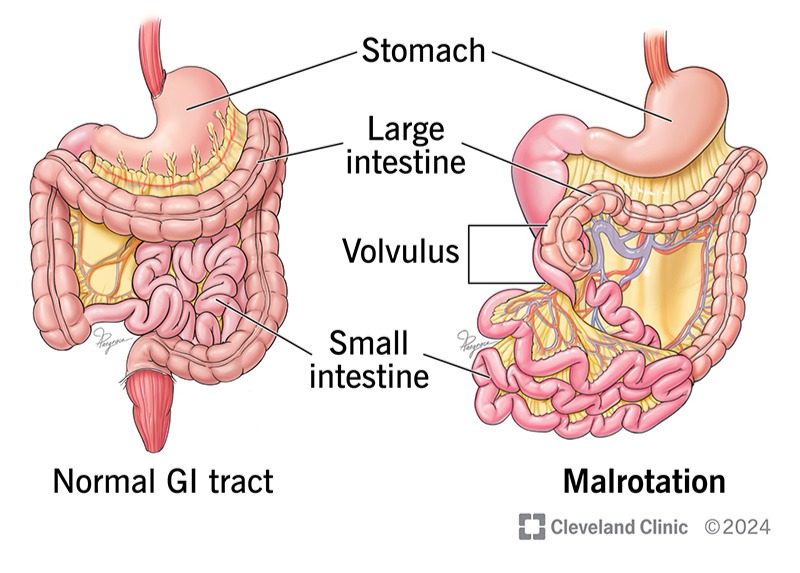A Guide for the Newly Diagnosed & Their Families

One of the toughest tasks after an intestinal malrotation diagnosis is finding updated information on the rare condition. Most people haven’t heard of it until it suddenly becomes personal. This guide is here to explain the basics in plain language—no medical degree required—so you can start making sense of what’s going on and what comes next.
First Things First: You Were Born With It—But That Doesn’t Mean It Shows Up Right Away
Intestinal malrotation is a condition that forms during fetal development, when the intestines don’t rotate and anchor in the usual position.
But it’s important to know: it’s always been there, even if it didn’t cause problems right away. Some people show symptoms in the first days of life. Others don’t get diagnosed until they’re teens or adults—often after years of unexplained digestive symptoms.
How Common Is Intestinal Malrotation, Really?
You might read that malrotation happens in about 1 in 500 births, but that number is based on older studies that only counted people who had surgery right away.
More recent thinking suggests that symptomatic malrotation affects 1 in 2,000 people. Medical researchers and doctors still haven’t figured out why some people show symptoms from birth while others never do (or develop symptoms later in life).
A lot of medical literature focuses on infants, but intestinal malrotation is not just a newborn problem. It can be diagnosed in toddlers, older kids, teens, and even adults. In fact, many adults go years without knowing they have it, often being treated for reflux, IBS, chronic constipation, anxiety, or other gut-related disorders instead.
It’s Not Just a Baby Issue
If you’re an adult getting diagnosed now, it didn’t suddenly appear. It’s been there all along—just under the radar.
New Thinking: A Disease of the Mesentery
Traditionally, malrotation was viewed as a structural issue—a “twisted gut.” But new research reframes that thinking.
Dr. Kareem Abu-Elmagd and his colleagues propose that intestinal malrotation is best understood as a disease of the mesentery—the tissue that supports and stabilizes the intestines. If the mesentery doesn’t form correctly in utero, it leaves the intestines more mobile than they should be, raising the risk for volvulus (a dangerous twist), obstruction, and long-term complications.
This helps explain why malrotation symptoms don’t always go away after surgery. It is widely thought that co-existing conditions affecting other systems, such as motility issues, play a role in lingering issues.
Malrotation Is Often Linked to Other Body Systems
Malrotation isn’t always just about where the intestines are—it can impact how the gut works, too. Many patients experience:
- Digestive Motility Issues (food moving too slowly or irregularly)
- Feeding Difficulties/Absorption Issues
- Autonomic Nervous System Symptoms, like temperature instability, dizziness, or blood sugar fluctuations
The mesentery isn’t just a physical support—it houses blood vessels and nerves. So when it’s abnormal, the effects can ripple through multiple systems.
You’re Not Alone
It can feel isolating to be diagnosed with something most people haven’t heard of, especially if your symptoms were dismissed for a long time. But you’re not alone. There’s a growing community of families, patients, and professionals working to spread awareness and push for better care and understanding. The Malro Fighters Foundation is here to help you through it and offers a handful of resources you can take to your doctors. Follow us on our socials for daily information and tips.







